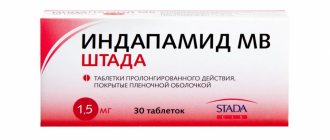Aminazine, 100 mg, film-coated tablets, 10 pcs.
During treatment, it is necessary to regularly monitor blood pressure, pulse, liver and kidney function. It is also necessary to monitor the blood picture (at first weekly, and then every 3-4 months); if during therapy the number of leukocytes decreases to 3.0-3.5x109/l, and the number of neutrophils decreases to 1.5-2.0x109/l, these indicators should be monitored 2 times a week; if leukocytosis and granulocytopenia occur, treatment should be interrupted.
Each patient should be informed that if they have a fever, sore throat or other manifestations of infectious diseases, they should immediately notify their doctor. In the event of hyperthermia, which may be one of the symptoms of neuroleptic malignant syndrome (pallor, hyperthermia, autonomic dysfunction, changes in consciousness, muscle rigidity), the drug Aminazine should be discontinued immediately. Early manifestations preceding the onset of hyperthermia may include side effects such as increased sweating and instability of blood pressure (BP). Although the etiology of the dependence of such side effects on antipsychotics is most often unknown, there are a number of risk factors: individual predisposition, dehydration, organic brain damage. Neuroleptic malignant syndrome can occur at any time during treatment with antipsychotic drugs and can be fatal.
If signs and symptoms of tardive dyskinesia occur, consider reducing the dose or discontinuing all antipsychotic medications. Tardive dyskinesia sometimes occurs after discontinuation of the antipsychotic and disappears with repeated use or increased dosage. Prescription of antiparkinsonian and anticholinergic drugs in the development of tardive dyskinesia is contraindicated (the condition may worsen).
Antiparkinsonian drugs - trihexyphenidyl and others - are used as correctors for extrapyramidal disorders, the occurrence of which is possible with the use of the drug Aminazin®.
Aminazine®, depending on the dose, may increase the prolongation of the QT interval, which increases the risk of ventricular arrhythmias, including the “pirouette” type. Bradycardia, hypokalemia, and congenital or acquired long QT period also increase. Therefore, before starting treatment, you must ensure that:
- bradycardia below 55 beats per minute;
- hypokalemia;
- congenital prolongation of the QT interval.
Except in emergency situations, it is recommended to perform an ECG during the preliminary examination of patients requiring treatment with an antipsychotic.
In randomized clinical trials in elderly patients with dementia, atypical antipsychotic drugs (AEDs) were found to have an increased risk of stroke compared with placebo. The mechanism for this increased risk is not known. An increased risk with other antipsychotics or in other age groups cannot be excluded. Aminazine should be used with caution in patients with risk factors for stroke, in elderly patients with dementia, since the risk of mortality increases in elderly patients with psychoses associated with dementia and receiving antipsychotic drugs. Placebo-controlled studies, which were conducted primarily in patients taking atypical antipsychotic drugs, showed a 1.6- to 1.7-fold increased risk of mortality compared with placebo. At the end of treatment, lasting an average of 10 weeks, the risk of mortality was 4.5% in the chlorpromazine group, compared with 2.6% in the placebo group. Although the causes of death in clinical studies with atypical antipsychotics varied, the majority of these deaths were the result of cardiovascular problems (eg, heart failure, sudden death) or infections (eg, pneumonia).
There is a risk of venous thromboembolism (VTE) during treatment with antipsychotics. In patients receiving antipsychotic drugs, especially those with acquired risk factors for VTE, preventive measures should be taken and any potential risk factor for VTE should be assessed before and during treatment with Aminazine®.
Except in exceptional circumstances, Aminazine® should not be used in Parkinson's disease.
The occurrence of intestinal obstruction, which can be detected by bloating and abdominal pain, requires emergency care.
Predisposing factors for the development of arrhythmia when taking Aminazin® are: hypokalemia (including when using diuretics that cause hypokalemia), bradycardia (including those caused by drugs), an existing (congenital or acquired) increase in the duration of the QT interval. The simultaneous administration of chlorpromazine with dopaminergic non-antiparkinsonian drugs (cabergoline, quinagolide) is not recommended due to the mutual antagonism of dopamine agonists and antipsychotics. Concomitant use with other antipsychotics that can cause irritation (amisulpride, cyamemazine, droperidol, fluphenazine, propericiazine, haloperidol, levomepromazine, pimozide, pipamperone, pipothiazine, sertindole, sulpiride, sultopride, tiapride) is not recommended. Concomitant use with antiparasitic drugs (halofantrine, lumefantrine, pentamidine) is not recommended. Also, simultaneous use with antifungal agents from the azole group is not recommended (increased risk of arrhythmia). If it is impossible to avoid the co-administration of the above combinations, it is recommended to carry out regular ECG monitoring with monitoring of the duration of the QT interval. When using non-potassium-sparing diuretics, correction of hypokalemia and ECG monitoring are necessary before starting chlorpromazine therapy.
Monitoring during treatment with Aminazine should be intensified:
- in patients with epilepsy and a history of seizures, due to the possibility of lowering the seizure threshold. The occurrence of seizures requires cessation of treatment.
- in elderly patients with:
a) high susceptibility and effect of orthostatic hypotension (increased risk of excessive sedation and hypotensive effects),
b) chronic constipation (risk of paralytic intestinal obstruction),
c) possible prostate hypertrophy;
- in patients with cardiovascular diseases taking quinidine, due to a possible increase in the hypotensive effect;
- in case of liver failure and/or severe renal failure, due to the risk of accumulation.
For long-term treatment, regular ophthalmological monitoring is recommended.
It should be taken into account that the use of phenothiazine derivatives can lead to hyperglycemia or impaired glucose tolerance, development or exacerbation of diabetes mellitus, hypercholesterolemia, fecal impaction, severe intestinal obstruction and megacolon.
Since in high doses (100 mg/day) chlorpromazine can cause an increase in blood glucose levels by reducing insulin secretion, in patients with diabetes mellitus it is necessary to adjust insulin doses before and after completion of therapy. If necessary, the dose of the antipsychotic should also be adjusted in patients taking sulfonylureas.
Chlorpromazine should not be used as monotherapy if depression predominates.
Aminazine® should be used with caution in case of hypersensitivity to other phenothiazine drugs or severe respiratory diseases.
Due to the risk of photosensitivity, ultraviolet irradiation should be avoided.
Aminazine® can worsen the course or promote the manifestation of latent myasthenia gravis, as well as cause myasthenic syndrome.
To avoid the development of withdrawal syndrome, it is necessary to stop treatment with Aminazin® gradually.
The mutual antagonism of levodopa and antipsychotics must be taken into account. Dopamine may cause or worsen psychotic disorders. To treat patients suffering from parkinsonism, it is necessary to use minimal effective doses of both drugs. If it is necessary to treat patients with parkinsonism treated with dopamine with antipsychotics, the dose of the latter should be reduced gradually to a minimum (abrupt withdrawal of dopamine may increase the risk of developing “neuroleptic malignant syndrome”).
In patients with pheochromacetoma taking Aminazine®, false positive results of catecholamine levels in the blood may be observed.
During therapy, it is necessary to stop drinking alcohol, since chlorpromazine enhances the inhibitory effect of alcohol on the central nervous system.
Impact on the ability to drive vehicles and operate machinery:
During the treatment period, it is necessary to refrain from engaging in potentially hazardous activities that require increased concentration and speed of psychomotor reactions.
Aminazine, 25 mg, film-coated tablets, 10 pcs.
During treatment, it is necessary to regularly monitor blood pressure, pulse, liver and kidney function. It is also necessary to monitor the blood picture (at first weekly, and then every 3-4 months); if during therapy the number of leukocytes decreases to 3.0-3.5x109/l, and the number of neutrophils decreases to 1.5-2.0x109/l, these indicators should be monitored 2 times a week; if leukocytosis and granulocytopenia occur, treatment should be interrupted.
Each patient should be informed that if they have a fever, sore throat or other manifestations of infectious diseases, they should immediately notify their doctor. In the event of hyperthermia, which may be one of the symptoms of neuroleptic malignant syndrome (pallor, hyperthermia, autonomic dysfunction, changes in consciousness, muscle rigidity), the drug Aminazine should be discontinued immediately. Early manifestations preceding the onset of hyperthermia may include side effects such as increased sweating and instability of blood pressure (BP). Although the etiology of the dependence of such side effects on antipsychotics is most often unknown, there are a number of risk factors: individual predisposition, dehydration, organic brain damage. Neuroleptic malignant syndrome can occur at any time during treatment with antipsychotic drugs and can be fatal.
If signs and symptoms of tardive dyskinesia occur, consider reducing the dose or discontinuing all antipsychotic medications. Tardive dyskinesia sometimes occurs after discontinuation of the antipsychotic and disappears with repeated use or increased dosage. Prescription of antiparkinsonian and anticholinergic drugs in the development of tardive dyskinesia is contraindicated (the condition may worsen).
Antiparkinsonian drugs - trihexyphenidyl and others - are used as correctors for extrapyramidal disorders, the occurrence of which is possible with the use of the drug Aminazin®.
Aminazine®, depending on the dose, may increase the prolongation of the QT interval, which increases the risk of ventricular arrhythmias, including the “pirouette” type. Bradycardia, hypokalemia, and congenital or acquired long QT period also increase. Therefore, before starting treatment, you must ensure that:
- bradycardia below 55 beats per minute;
- hypokalemia;
- congenital prolongation of the QT interval.
Except in emergency situations, it is recommended to perform an ECG during the preliminary examination of patients requiring treatment with an antipsychotic.
In randomized clinical trials in elderly patients with dementia, atypical antipsychotic drugs (AEDs) were found to have an increased risk of stroke compared with placebo. The mechanism for this increased risk is not known. An increased risk with other antipsychotics or in other age groups cannot be excluded. Aminazine should be used with caution in patients with risk factors for stroke, in elderly patients with dementia, since the risk of mortality increases in elderly patients with psychoses associated with dementia and receiving antipsychotic drugs. Placebo-controlled studies, which were conducted primarily in patients taking atypical antipsychotic drugs, showed a 1.6- to 1.7-fold increased risk of mortality compared with placebo. At the end of treatment, lasting an average of 10 weeks, the risk of mortality was 4.5% in the chlorpromazine group, compared with 2.6% in the placebo group. Although the causes of death in clinical studies with atypical antipsychotics varied, the majority of these deaths were the result of cardiovascular problems (eg, heart failure, sudden death) or infections (eg, pneumonia).
There is a risk of venous thromboembolism (VTE) during treatment with antipsychotics. In patients receiving antipsychotic drugs, especially those with acquired risk factors for VTE, preventive measures should be taken and any potential risk factor for VTE should be assessed before and during treatment with Aminazine®.
Except in exceptional circumstances, Aminazine® should not be used in Parkinson's disease.
The occurrence of intestinal obstruction, which can be detected by bloating and abdominal pain, requires emergency care.
Predisposing factors for the development of arrhythmia when taking Aminazin® are: hypokalemia (including when using diuretics that cause hypokalemia), bradycardia (including those caused by drugs), an existing (congenital or acquired) increase in the duration of the QT interval. The simultaneous administration of chlorpromazine with dopaminergic non-antiparkinsonian drugs (cabergoline, quinagolide) is not recommended due to the mutual antagonism of dopamine agonists and antipsychotics. Concomitant use with other antipsychotics that can cause irritation (amisulpride, cyamemazine, droperidol, fluphenazine, propericiazine, haloperidol, levomepromazine, pimozide, pipamperone, pipothiazine, sertindole, sulpiride, sultopride, tiapride) is not recommended. Concomitant use with antiparasitic drugs (halofantrine, lumefantrine, pentamidine) is not recommended. Also, simultaneous use with antifungal agents from the azole group is not recommended (increased risk of arrhythmia). If it is impossible to avoid the co-administration of the above combinations, it is recommended to carry out regular ECG monitoring with monitoring of the duration of the QT interval. When using non-potassium-sparing diuretics, correction of hypokalemia and ECG monitoring are necessary before starting chlorpromazine therapy.
Monitoring during treatment with Aminazine should be intensified:
- in patients with epilepsy and a history of seizures, due to the possibility of lowering the seizure threshold. The occurrence of seizures requires cessation of treatment.
- in elderly patients with:
a) high susceptibility and effect of orthostatic hypotension (increased risk of excessive sedation and hypotensive effects),
b) chronic constipation (risk of paralytic intestinal obstruction),
c) possible prostate hypertrophy;
- in patients with cardiovascular diseases taking quinidine, due to a possible increase in the hypotensive effect;
- in case of liver failure and/or severe renal failure, due to the risk of accumulation.
For long-term treatment, regular ophthalmological monitoring is recommended.
It should be taken into account that the use of phenothiazine derivatives can lead to hyperglycemia or impaired glucose tolerance, development or exacerbation of diabetes mellitus, hypercholesterolemia, fecal impaction, severe intestinal obstruction and megacolon.
Since in high doses (100 mg/day) chlorpromazine can cause an increase in blood glucose levels by reducing insulin secretion, in patients with diabetes mellitus it is necessary to adjust insulin doses before and after completion of therapy. If necessary, the dose of the antipsychotic should also be adjusted in patients taking sulfonylureas.
Chlorpromazine should not be used as monotherapy if depression predominates.
Aminazine® should be used with caution in case of hypersensitivity to other phenothiazine drugs or severe respiratory diseases.
Due to the risk of photosensitivity, ultraviolet irradiation should be avoided.
Aminazine® can worsen the course or promote the manifestation of latent myasthenia gravis, as well as cause myasthenic syndrome.
To avoid the development of withdrawal syndrome, it is necessary to stop treatment with Aminazin® gradually.
The mutual antagonism of levodopa and antipsychotics must be taken into account. Dopamine may cause or worsen psychotic disorders. To treat patients suffering from parkinsonism, it is necessary to use minimal effective doses of both drugs. If it is necessary to treat patients with parkinsonism treated with dopamine with antipsychotics, the dose of the latter should be reduced gradually to a minimum (abrupt withdrawal of dopamine may increase the risk of developing “neuroleptic malignant syndrome”).
In patients with pheochromacetoma taking Aminazine®, false positive results of catecholamine levels in the blood may be observed.
During therapy, it is necessary to stop drinking alcohol, since chlorpromazine enhances the inhibitory effect of alcohol on the central nervous system.
Impact on the ability to drive vehicles and operate machinery:
During the treatment period, it is necessary to refrain from engaging in potentially hazardous activities that require increased concentration and speed of psychomotor reactions.


